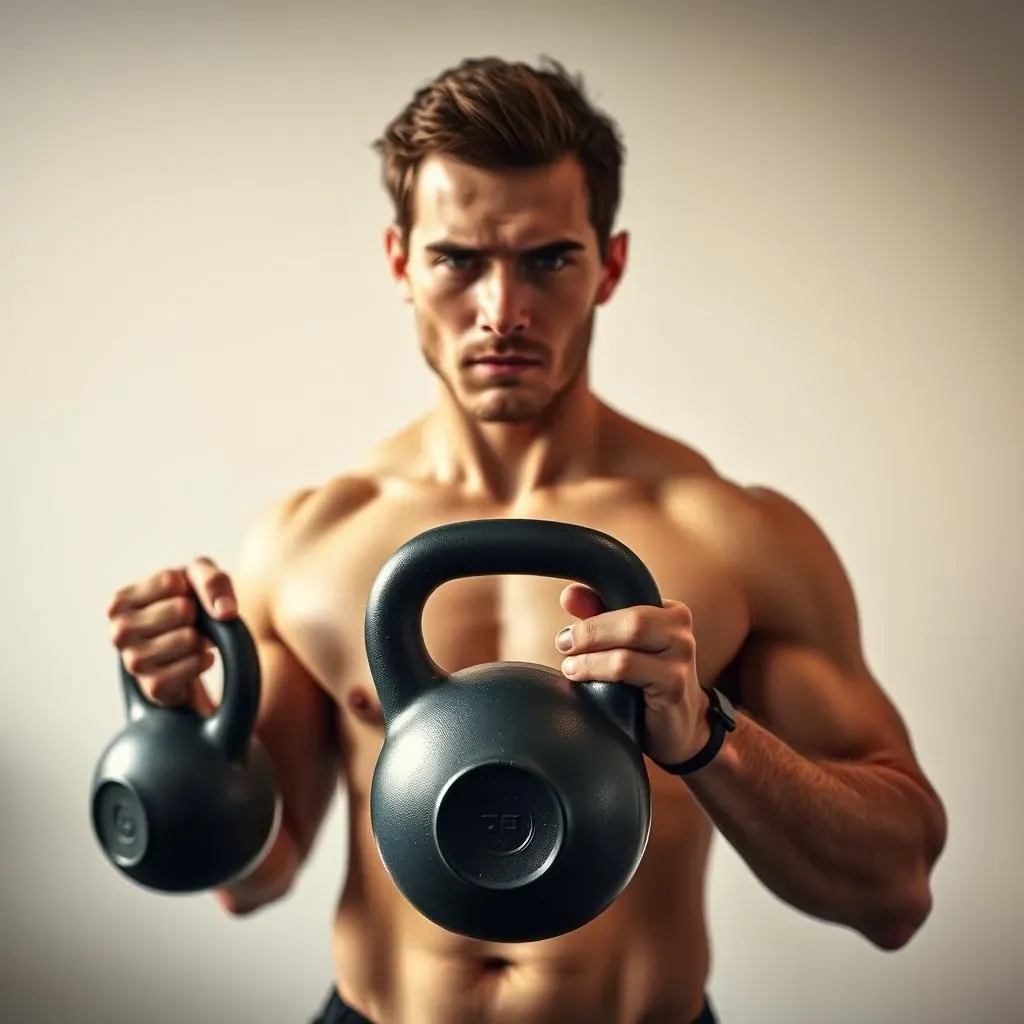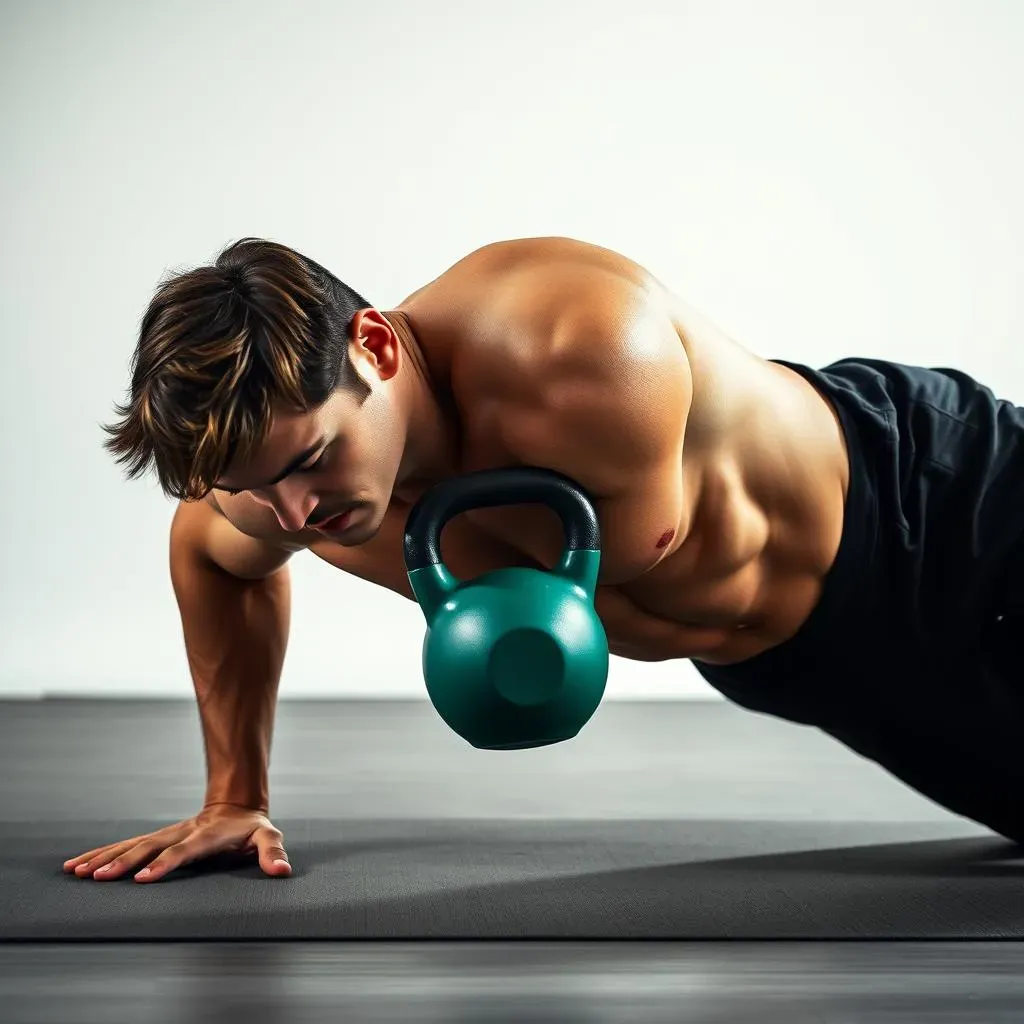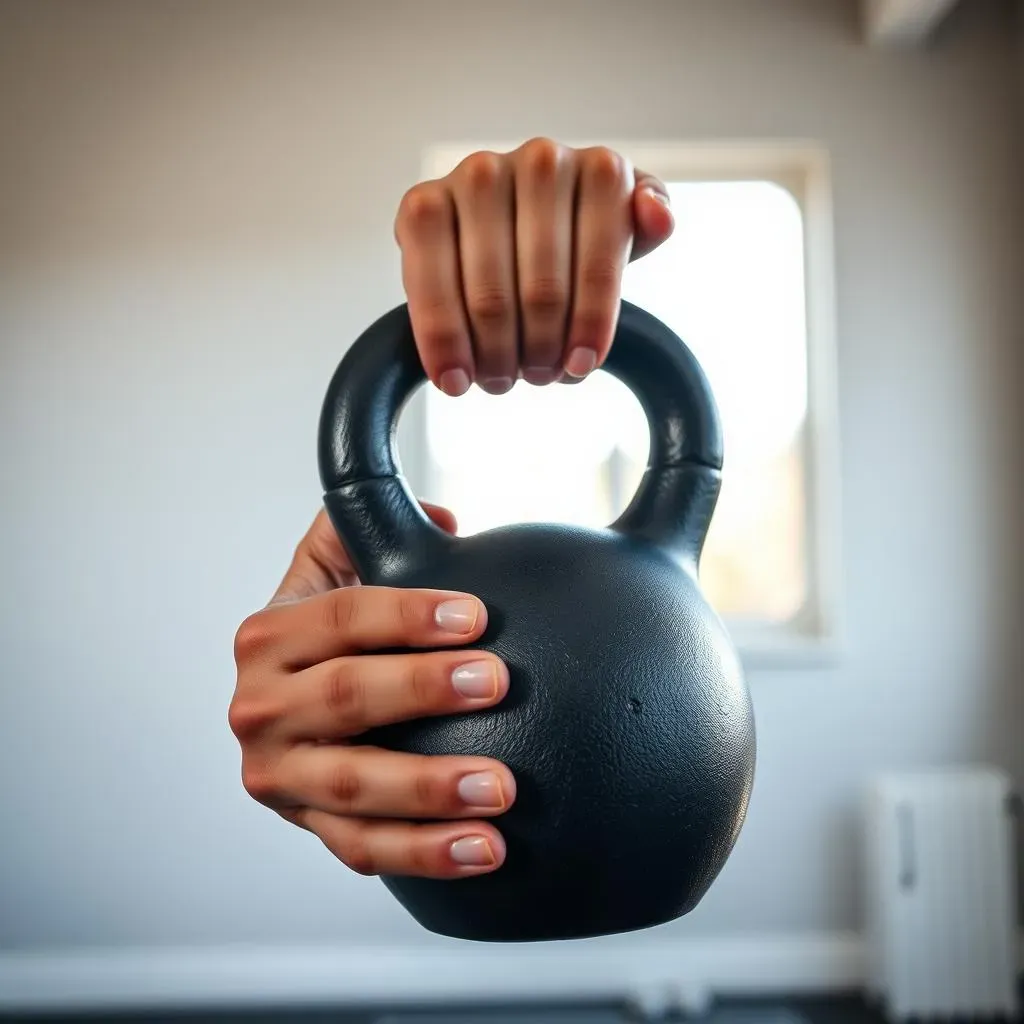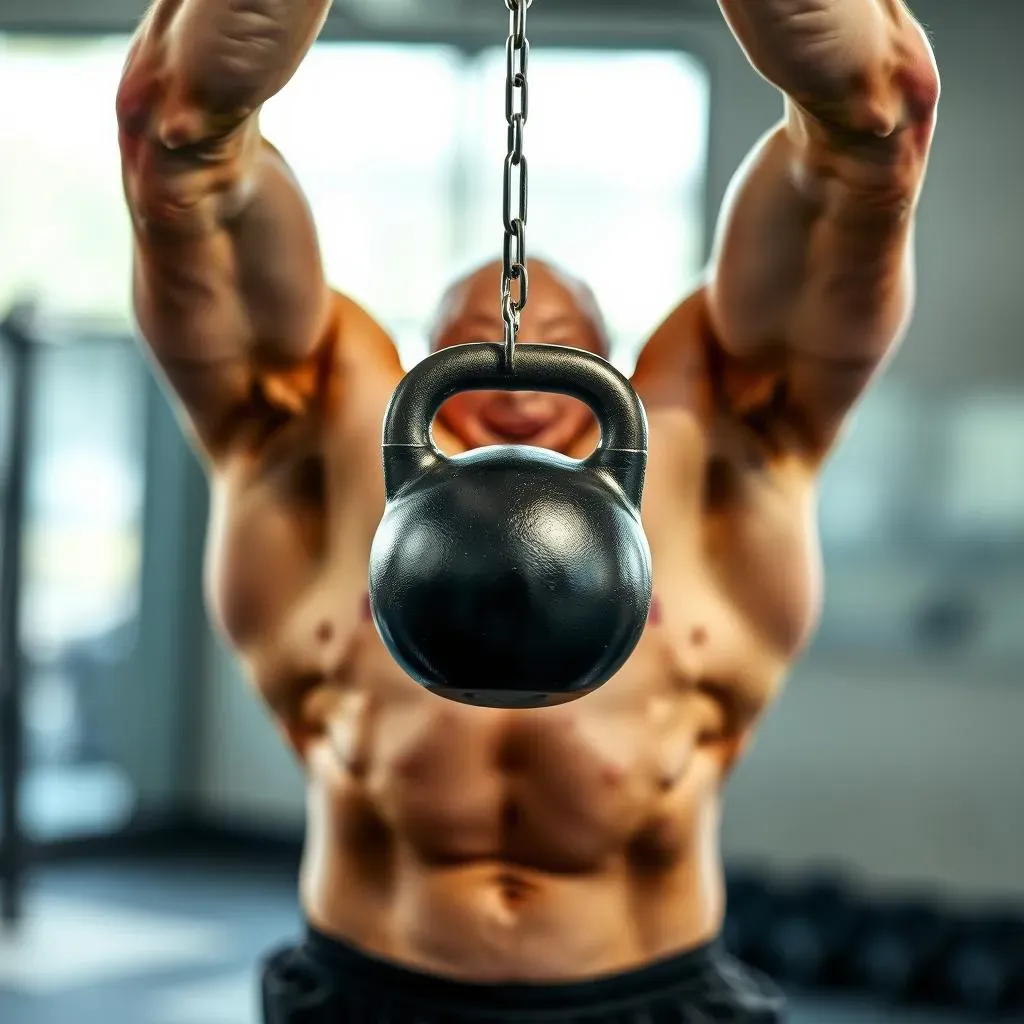Table of Contents
Ready to shake up your chest day? Forget the same old dumbbells and barbells. We're diving into the world of kettlebells. Yes, those cannonball-looking weights aren't just for swings and squats. They are amazing for a killer chest workout. Think about it, a tool that's not only great for building strength but also improves your grip and stability. This article will show you the five best kettlebell exercises for your chest. We will cover the kettlebell floor press, bench press, incline press, flyes, and deficit push-ups. We’ll also talk about why kettlebells are so awesome, how to make the most of your workout, and how to avoid hurting yourself. So, if you're looking for a new challenge and want to see some serious gains, keep reading. It's time to unlock the power of the kettlebell for your chest workout.
Benefits of Working Out With Kettlebells for Chest

Benefits of Working Out With Kettlebells for Chest
More Than Just a Swing
so you've probably seen people swinging kettlebells like they're auditioning for a strongman competition. But these things are so much more than just a tool for those dynamic moves. When it comes to your chest, kettlebells offer a unique advantage. You see, unlike dumbbells, the weight of a kettlebell isn't evenly distributed. This means your muscles have to work harder to control it. This extra effort leads to better muscle activation and strength gains. It's not just about lifting heavy; it's about lifting smart.
Grip Strength and Stability
Ever feel like your grip is the weak link in your chest workout? Kettlebells can help with that. Because of the way you hold them, your grip gets a serious workout every single rep. This improved grip strength isn't just good for lifting; it's useful in everyday life. Plus, the offset weight challenges your stability. This forces your core and other supporting muscles to engage, making your chest exercises more effective and holistic.
Benefit | How it Helps |
|---|---|
Improved Muscle Activation | Uneven weight distribution forces muscles to work harder. |
Enhanced Grip Strength | Unique handle design challenges grip during exercises. |
Increased Stability | Offset weight engages core and supporting muscles. |
A Different Kind of Challenge
Let's face it, sometimes the same old routine gets boring. Kettlebells offer a fresh way to challenge your chest. The range of motion you can achieve with kettlebells is different than with dumbbells or barbells, which can help you hit your muscles from new angles. This means better overall development and potentially breaking through plateaus. It’s like giving your chest muscles a new puzzle to solve, and they'll thank you for it.
Top Kettlebell Chest Exercises You Should Be Doing

Top Kettlebell Chest Exercises You Should Be Doing
Kettlebell Floor Press: Your New Best Friend
let's talk about the floor press. It's like a bench press but on the floor, which might sound less fancy but is actually super effective. You lie down, hold a kettlebell in one hand, and press it up. It's not just about pushing; it's about controlling the weight and keeping your core engaged. The floor limits your range of motion, which can be great for focusing on chest activation. I remember the first time I tried this, I was surprised at how much my chest was working, even without a bench.
The beauty of the kettlebell floor press lies in its simplicity. It's not a complex movement, but it's highly effective. You can do it anywhere, anytime, with just one kettlebell. It's also fantastic for identifying imbalances. If one side feels significantly weaker, you know where to focus your efforts. It's a humble exercise that delivers big results.
Bench Press with Kettlebells: A Twist on a Classic
Now, if you have a bench, let's level up. The bench press with kettlebells is a classic move with a kettlebell twist. Instead of a barbell, you're holding kettlebells, which means more stabilization and a deeper range of motion. It feels different, and that's a good thing. It's like giving your chest a new challenge it's not used to.
One thing I love about this variation is how it works your grip. Holding onto the kettlebells, especially as they get heavier, forces your forearms to work hard. This translates to better overall strength and control. Plus, it's just a fun way to mix up your routine. I've seen so many people stuck on the barbell bench, and switching to kettlebells can be the thing that gets them past that plateau.
Exercise | Why It's Great | How to Do It |
|---|---|---|
Kettlebell Floor Press | Focuses on chest activation, great for beginners. | Lie on the floor, press kettlebell up, control the descent. |
Bench Press with Kettlebells | Improves stabilization, challenges grip strength. | Lie on a bench, press kettlebells up, maintain control. |
Incline Bench Press with Kettlebells: Hitting the Upper Chest
Don't forget your upper chest! The incline bench press with kettlebells is the perfect way to target this area. It's the same concept as the flat bench press, but with the bench set at an incline. This slight change in angle makes a huge difference in muscle activation. It’s like giving your upper chest its own dedicated workout.
I've noticed that many people neglect their upper chest, and this exercise is a game-changer. By using kettlebells, you're not only hitting the upper chest but also improving your stabilizer muscles. It’s a fantastic way to get a more balanced and complete chest workout. So, if you want a well-rounded chest, make sure to include this exercise in your routine.
Kettlebell Flyes: Stretching and Strengthening
Now, let's stretch things out with kettlebell flyes. Instead of pressing, you're bringing the kettlebells together in an arc. This move stretches your chest muscles while also working them. It's like giving your chest a big, satisfying hug, but with weights.
The key with flyes is control. You don't want to just swing the kettlebells around. Instead, focus on a slow, deliberate movement. Feel the stretch in your chest as you lower the kettlebells, and then squeeze your chest as you bring them back up. This exercise is excellent for improving muscle definition and flexibility.
Exercise | Target Area | Focus |
|---|---|---|
Incline Bench Press with Kettlebells | Upper Chest | Muscle activation in the upper chest area. |
Kettlebell Flyes | Chest Stretch | Stretching and strengthening chest muscles. |
Deficit Push-Up with Kettlebells: A Killer Combo
for our last exercise, let’s combine bodyweight with kettlebells. The deficit push-up with kettlebells is an advanced move, but it's incredibly effective. You place your hands on the kettlebells and perform a push-up, which allows you to go deeper than a regular push-up. This extra depth means more muscle activation. I remember struggling with these at first, but they quickly became one of my favorite moves.
This exercise is not for the faint of heart. It takes a lot of strength and control, but the payoff is huge. Not only do you work your chest, but you also engage your shoulders, triceps, and core. It’s a full-body exercise disguised as a chest move. If you’re looking for a way to challenge yourself and take your push-ups to the next level, give this one a try.
"The only way to do great work is to love what you do." - Steve Jobs
Tips for Maximizing Your Kettlebell Chest Workout

Tips for Maximizing Your Kettlebell Chest Workout
Hand Insertion and Grip: The Secret Weapon
so you've got your kettlebell, but are you holding it right? This is more important than you think. Proper hand insertion and grip are crucial for maximizing muscle activation and preventing injuries. I've seen so many people just grab the handle and go, but that's not the way. You want to make sure your hand is placed correctly, with the handle resting in the palm of your hand, not in your fingers. A good grip will allow you to control the weight better and engage your chest muscles more effectively. Think of it like this: a solid foundation leads to a stronger building.
Grip is not just about holding on tight. It's about control and stability. The way you grip the kettlebell impacts how your muscles work. When you grip properly, you’re not just using your hand and forearm, but also engaging your chest and back muscles to stabilize the weight. This creates a chain reaction throughout your upper body, making the exercise much more effective. So, take a moment to focus on your grip. It's a small change that can make a big difference.
Double Progression: Your Path to Gains
Now, let's talk about how to actually get stronger. It's not just about randomly adding weight; it's about strategic progression. One of the best ways to do this is through double progression. This means that instead of just increasing the weight, you also increase the number of reps. For example, if you're doing 3 sets of 8 reps, try to get to 3 sets of 10 reps before increasing the weight. This way, you're not just getting stronger, but also building endurance. It’s like climbing a ladder: one step at a time, but always moving up.
I remember when I first started, I was so eager to just lift heavier. But I quickly realized that wasn't the smartest way to go. By focusing on increasing reps first, I built a solid foundation of strength and control. Then, when I did increase the weight, my body was better prepared. This not only led to bigger gains but also helped prevent injuries. Double progression is your friend; use it wisely.
Progression Method | Description | Benefits |
|---|---|---|
Double Progression | Increase reps, then weight | Builds both strength and endurance, reduces injury risk |
Seek Professional Guidance: Don't Be a Lone Wolf
Finally, if you're new to kettlebells or just want to make sure you're doing things right, don't be afraid to seek professional guidance. A good trainer or coach can help you with proper form, create a personalized workout plan, and keep you accountable. I know it might seem like an extra expense, but it's an investment in your health and fitness. It's like having a map for your fitness journey.
I've worked with coaches before, and it's always been eye-opening. They notice things you might miss on your own, and they can give you tips and tricks to get the most out of your workout. Plus, they can help you avoid common mistakes that can lead to injuries. So, if you're serious about getting the best results, don't hesitate to reach out to a professional. It's like having a mentor that pushes you to be your best.
"It's not about perfect. It's about effort. And when you bring that effort every single day, that's where transformation happens." - Jillian Michaels
How to Progress Safely in Your Kettlebell Chest Workout

How to Progress Safely in Your Kettlebell Chest Workout
Start Slow: Master the Basics First
so you're hyped to start throwing around kettlebells, but hold your horses. Before you go all out, you need to nail the basics. I mean, really nail them. It's like learning to drive; you don't start with a race car, you start with the basics. Make sure your form is perfect before you even think about adding weight. This means doing the exercises slowly and focusing on muscle activation, not just lifting the weight. I've seen too many people get hurt because they rushed into things. Trust me, a little patience goes a long way. Start with a lighter weight, even if it feels too easy. It's better to build a strong base than to get injured early on.
Think of your body as a finely tuned machine. If you try to push it too hard too soon, it's going to break down. Start with the basics, get comfortable with the movements, and then gradually increase the intensity. This approach will not only keep you safe but also lead to better results in the long run. I used to think that more was always better, but that’s not always the case. Sometimes, less is more, especially when you're learning a new exercise.
Listen to Your Body: The Ultimate Guide
Now, this might sound obvious, but it's so important. You need to listen to your body. If something hurts, stop. I mean it, don't push through pain. It's not a sign of weakness; it's a sign that something is wrong. I've had my fair share of injuries because I didn’t listen to my body. It's not worth it. There's a difference between muscle soreness and actual pain. If you're feeling sharp pain or discomfort, take a break and assess what's going on. Your body is the best guide you have, so pay attention to what it's telling you.
I know, it's tempting to ignore those little twinges, but they’re often early warning signs. Your body is communicating with you, so be a good listener. If you feel pain, it's your body telling you to slow down or adjust something. Pushing through pain can lead to serious injuries that can sideline you for weeks or months. Be smart, not stubborn. Remember that fitness is a marathon, not a sprint.
Safety Tip | Description |
|---|---|
Start Slow | Master the basics with light weight before progressing. |
Listen to Your Body | Stop if you feel pain; don't push through it. |
Progress Gradually: Small Steps, Big Results
Once you've nailed the basics and you're listening to your body, it's time to start thinking about progression. But don't go from zero to hero overnight. Gradual progression is key. Increase the weight, reps, or sets slowly over time. Don’t try to add 10 pounds every week. It’s much better to increase by 2.5 pounds or 5 pounds and add a rep or two each week. Small changes over time will lead to bigger results in the long run. It's like building a house; you lay the foundation first and then slowly build on top of it.
I've seen so many people get frustrated because they weren’t progressing as fast as they wanted. But the key is consistency and patience. Don’t compare your journey to someone else's. Focus on your own progress and celebrate small victories. If you're consistently working on getting better, you'll eventually get to where you want to be. Remember, it's not about how fast you get there, it's about making sure you get there safely and sustainably.
Don't Skip the Warm-Up and Cool-Down
Finally, let's talk about the often-neglected warm-up and cool-down. These aren't just extra steps; they're crucial for preparing your body for exercise and helping it recover afterwards. A good warm-up will increase your blood flow, loosen up your muscles, and get your body ready for the workout. I like to do some light cardio, like jumping jacks or jogging in place, followed by some dynamic stretches like arm circles and leg swings. It's like giving your body a heads-up that it's about to do some work.
And don't forget the cool-down. After your workout, take some time to do some static stretches, holding each stretch for about 30 seconds. This will help reduce muscle soreness and improve flexibility. I like to do some chest stretches, holding my arms out to the side or behind my back. It's like giving your body a nice, relaxing massage after a hard day's work. Warming up and cooling down are not optional; they're essential for a safe and effective workout.
"The pain you feel today will be the strength you feel tomorrow." - Arnold Schwarzenegger
Wrapping Up Your Kettlebell Chest Workout
So, there you have it. Kettlebells aren't just a trendy piece of gym equipment. They're a powerful tool for building a strong chest. We've covered five awesome exercises, from floor presses to deficit push-ups, and how to get the most out of them. Remember, it’s not just about lifting heavy, but lifting smart. Proper grip, controlled movements, and gradual progression are your best friends. Whether you're a seasoned lifter or just starting out, integrating kettlebells into your chest workout can bring a new dimension to your training. So, grab a kettlebell and give these exercises a try. You might just surprise yourself with how much you can achieve.